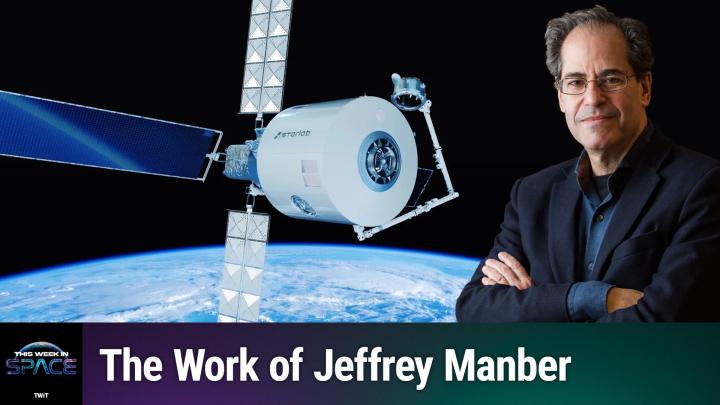In Photos: SpaceX's Amazing CRS-18 Dragon Flight for NASA!
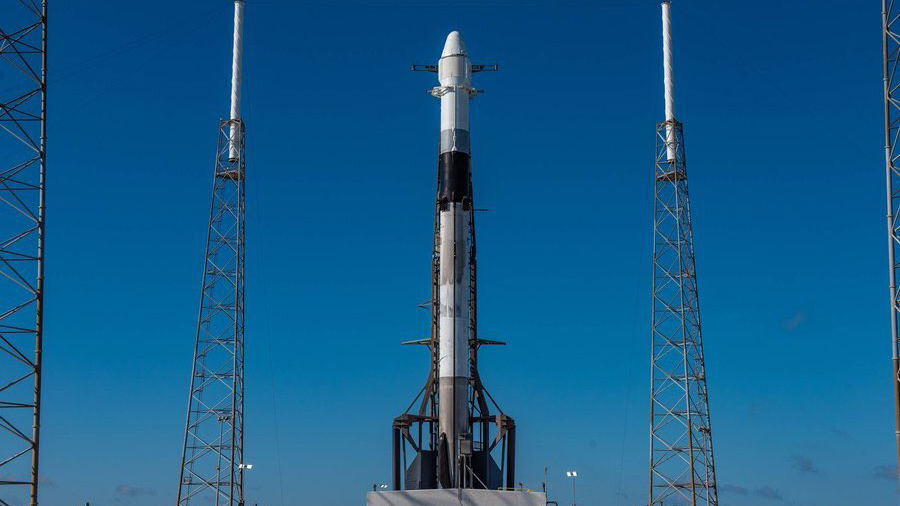
On July 25, 2019, a used SpaceX Falcon 9 rocket launched a Dragon cargo ship to the International Space Station to deliver 5,000 lbs. of NASA supplies to the orbiting laboratory's Expedition 60 crew. The early evening launch made for spectacular viewing for those lucky enough to witness it live.
But if you missed the it, we've got you covered. Here's a look back at the stunning launch of SpaceX's CRS-18 mission, as well as its smooth arrival at the International Space Station.
This image: The used Falcon 9 stands atop Space Launch Complex 40 at the Cape Canaveral Air Force Station in Florida awaiting its second launch. The Dragon atop the rocket made its third flight to the station on the mission.
Click the right arrow for more pictures!
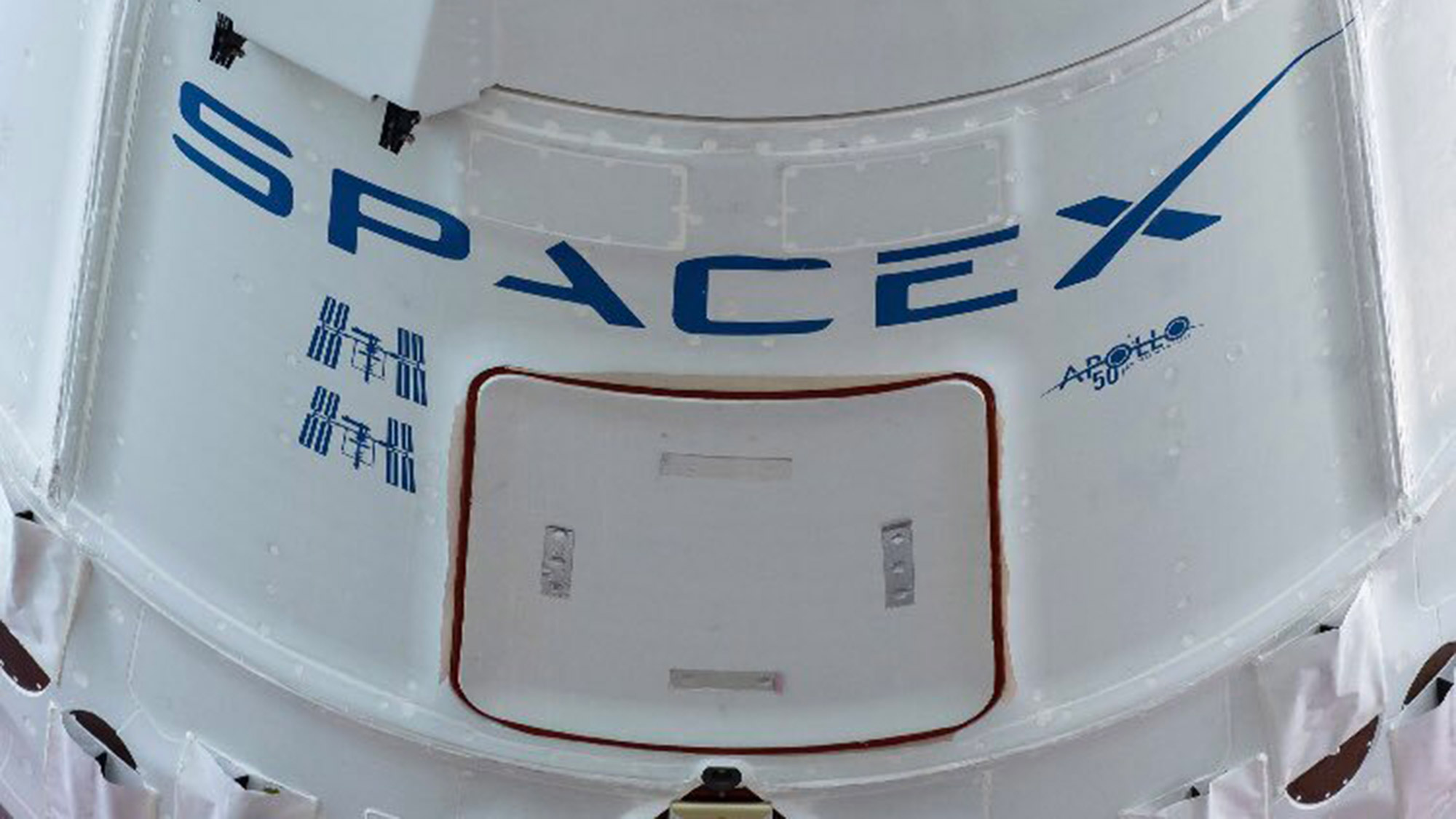
The Falcon 9 on CRS-18 wasn't the only reused spacecraft on the mission. The Dragon capsule had even more space miles on it, and made its third trip to orbit on the mission.
SpaceX first launched this particular Dragon in April 2015, then again in December 2017. Two space station emblems near the Dragon's hatch served as reminders of those two flights. A NASA Apollo 50th anniversary logo also adorned Dragon to celebrate the 50th anniversary of Apollo 11.
With this third flight, the CRS-18 Dragon became SpaceX's most-flown space capsule.
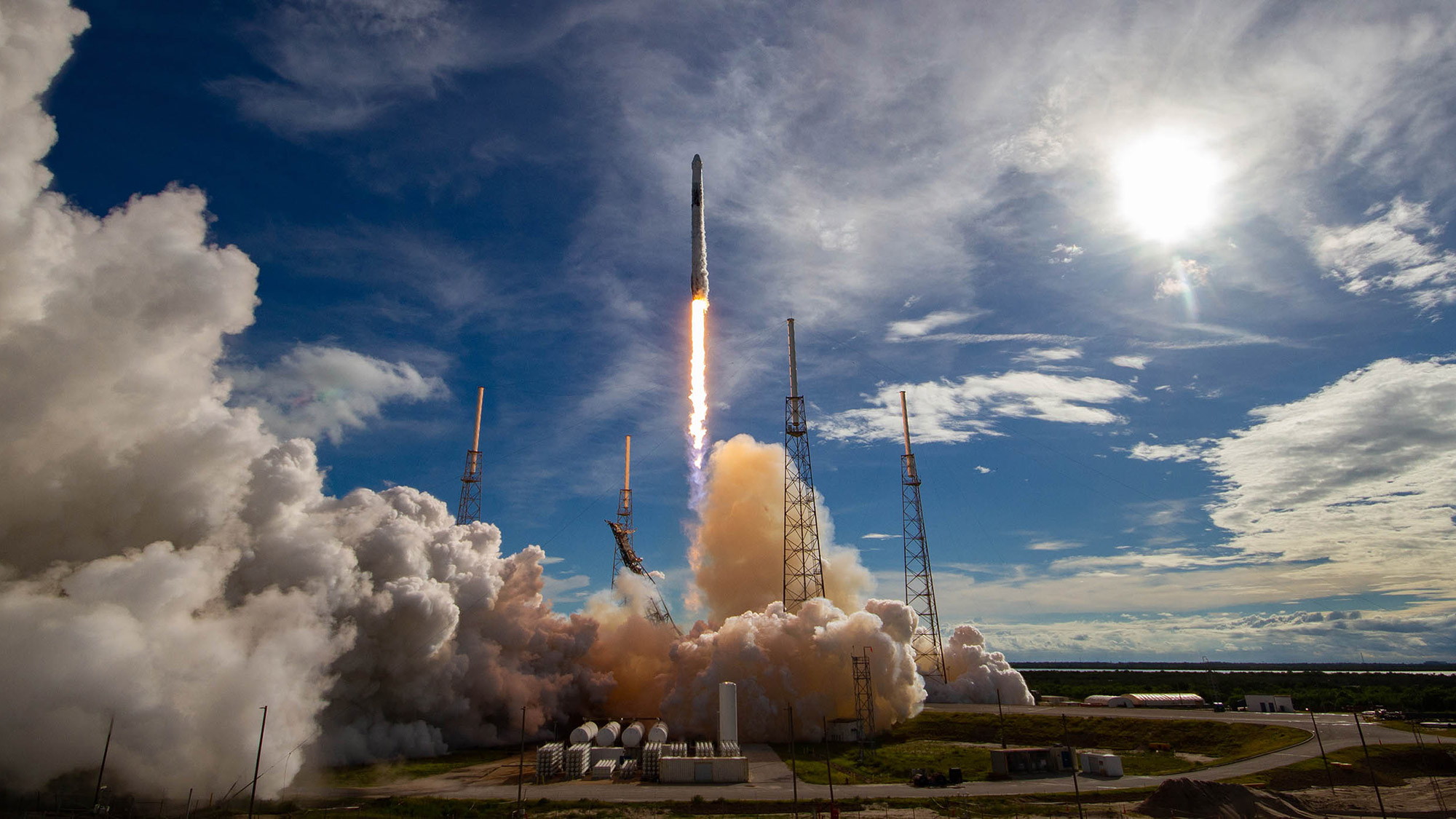
SpaceX launched the CRS-18 mission from Space Launch Complex 40 at Florida's Cape Canaveral Air Force Station at 6:01 p.m. EDT (2201 GMT) on Thursday, July 25, 2019. The mission was initially scheduled to launch a day earlier, but was delayed 24 hours by bad weather.
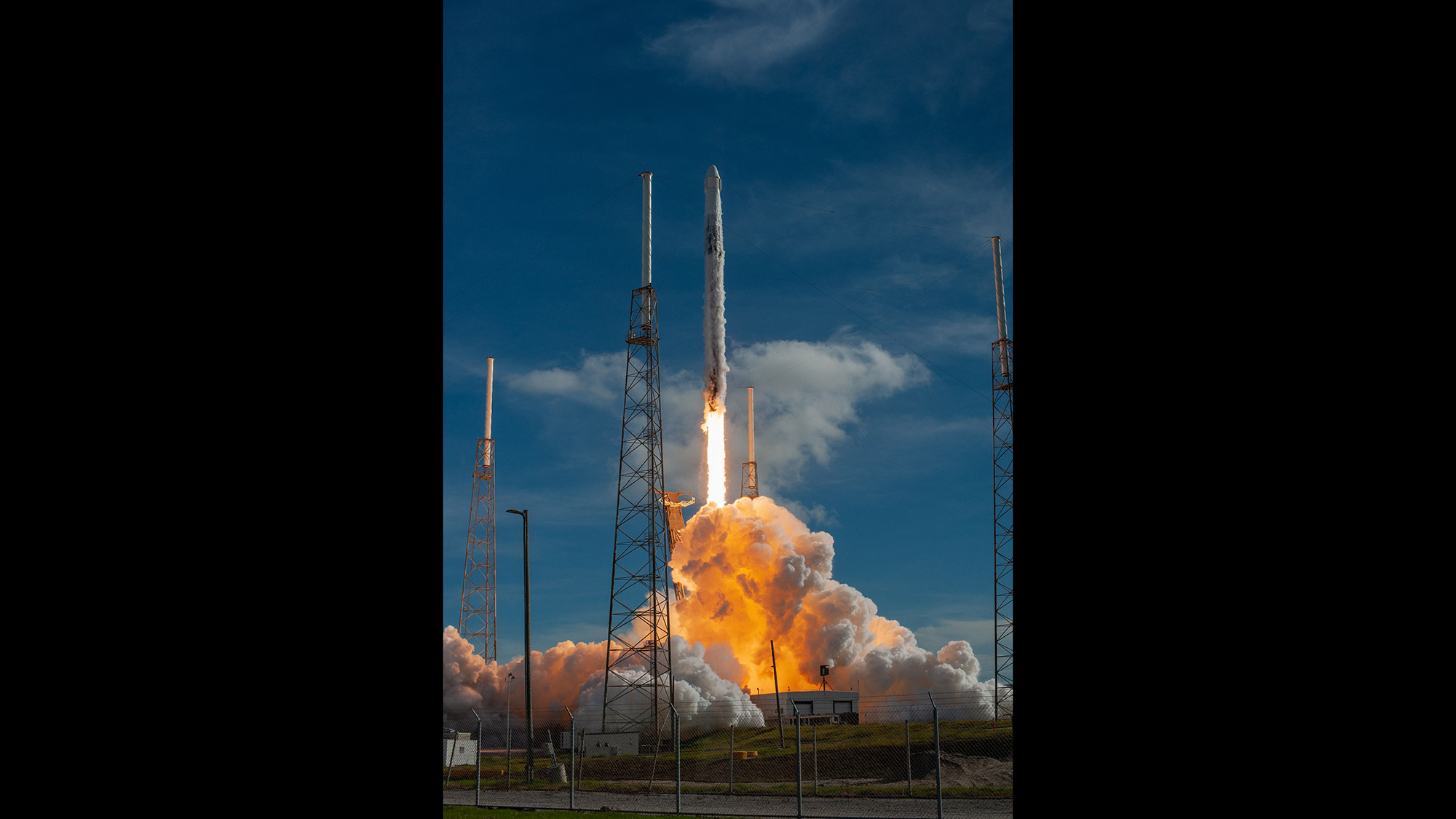
A view of SpaceX's Falcon 9 rocket lifting off from its launchpad. The Falcon 9 rocket is about 230 feet (70 meters) tall and can launch 50,265 lbs. (22,800 kg) of payload into orbit. When loaded for launch, SpaceX's Dragon weighs 13,228 lbs. (6,000 kg), according to SpaceX specs.
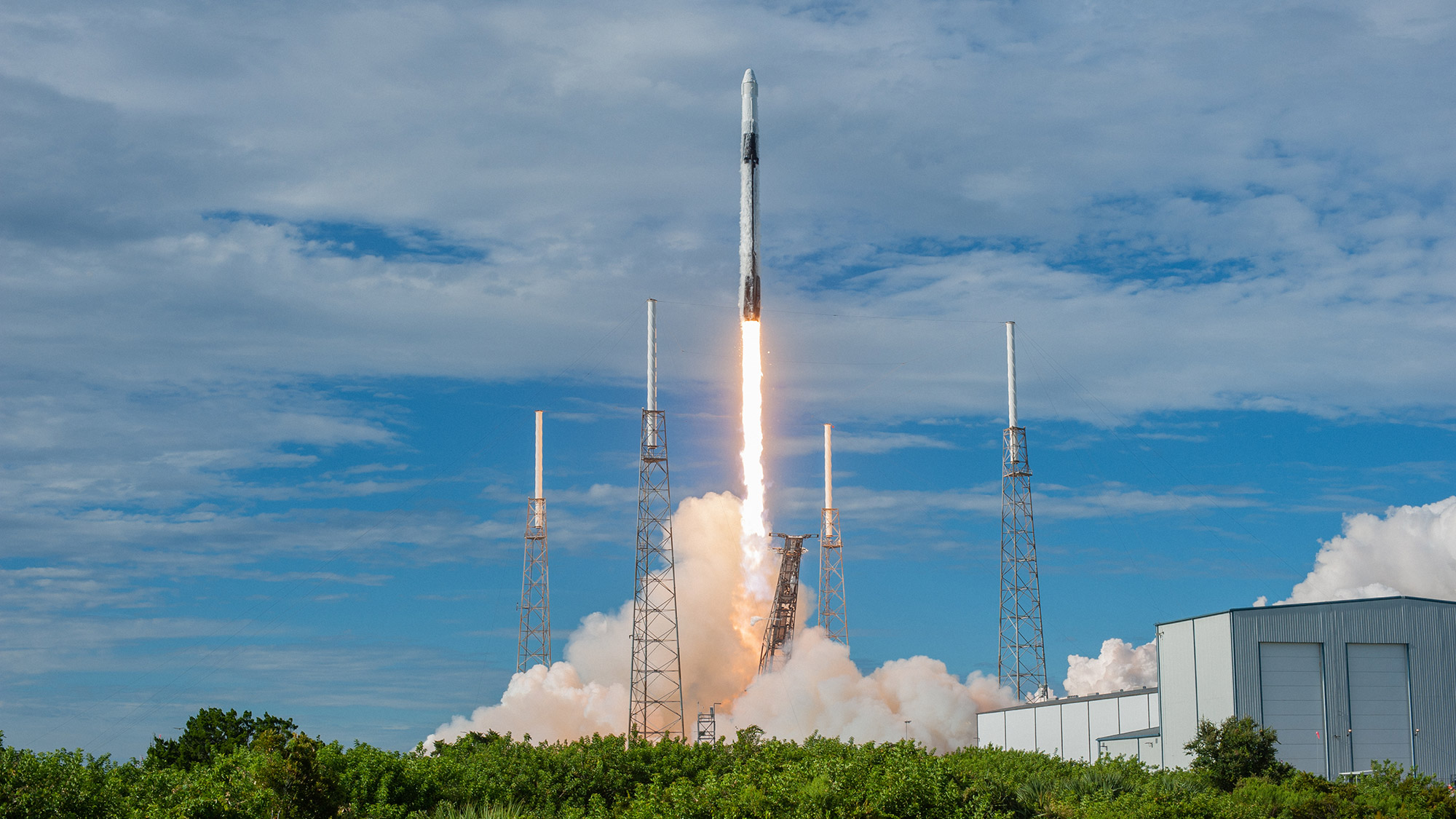
The used nature of SpaceX's CRS-18 Falcon 9 rocket is visible in this image, with the sooty appearance of the Falcon 9 first stage. The black angular components just above the engine plume are the four landing legs used during landing.
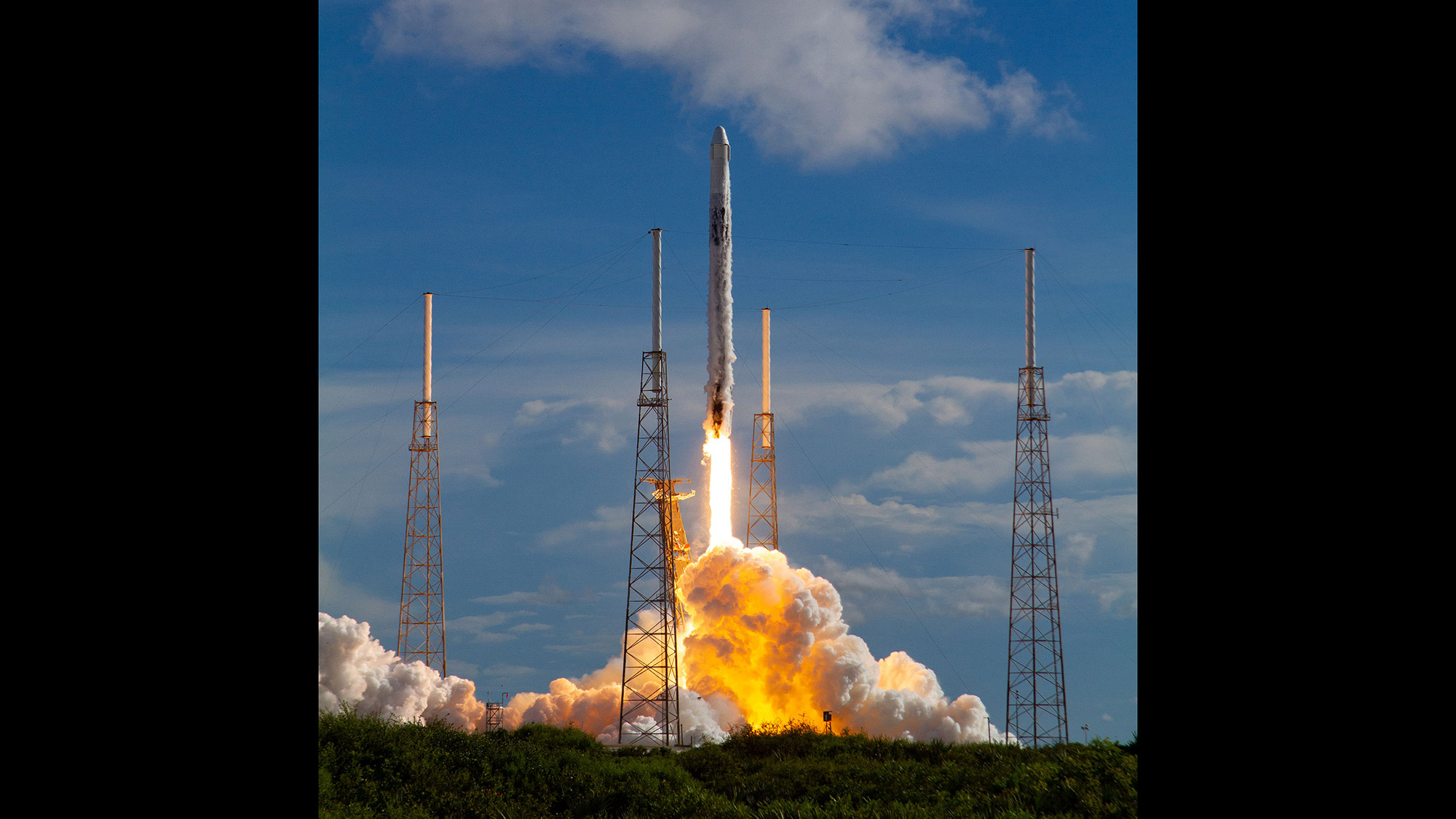
SpaceX actually has two launch pads in Florida. While CRS-18 launched from SLC-40 at Cape Canaveral Air Force Station, SpaceX can also launch Falcon 9 and Falcon Heavy rockets from NASA's historic Launch Pad 39A at the nearby Kennedy Space Center.
Crew Dragon, a crewed version of the automated Dragon supply ship, will launch astronauts from 39A as well.
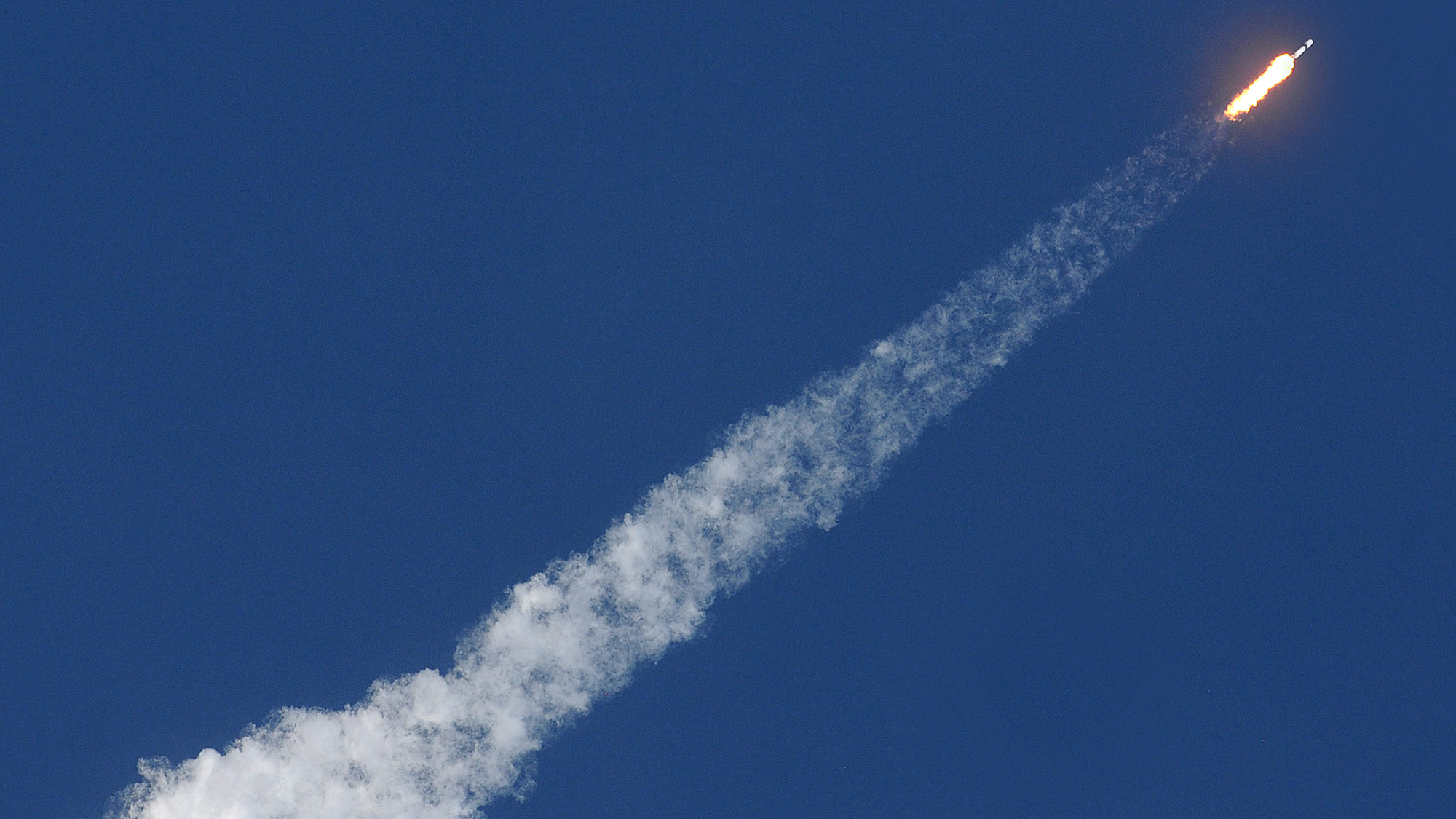
SpaceX's Falcon 9 streaks toward space in this amazing photo by photographer Paul Hennessy with the the Getty wire service.
From engine ignition to spacecraft separation, it took SpaceX about 9 minutes and 38 seconds to launch the CRS-18 Dragon cargo ship.
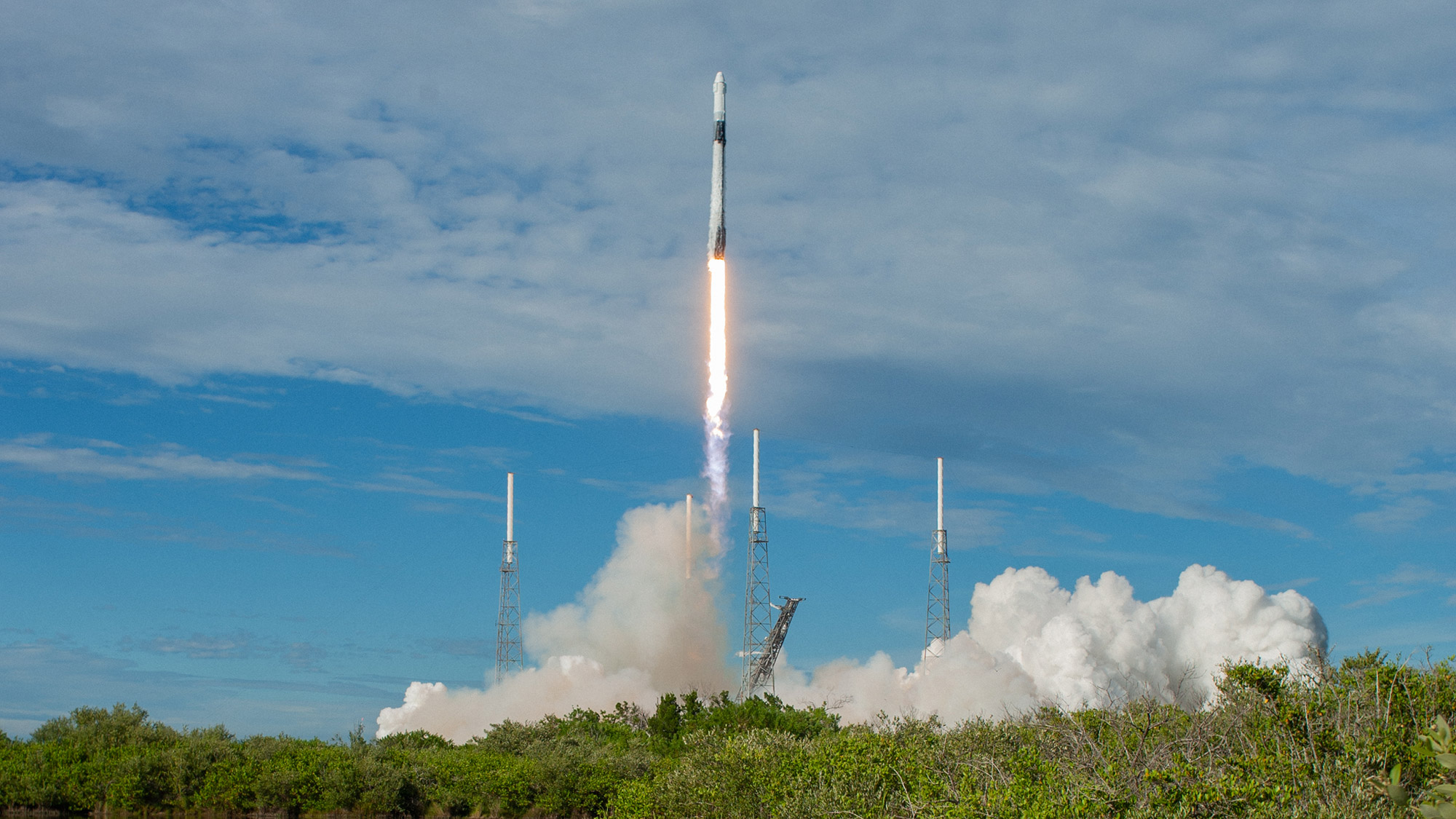
An exhaust plume from the Falcon 9's nine first-stage engines billows out as SpaceX launched the Dragon cargo ship.
SpaceX's Falcon 9 rockets use liquid oxygen and rocket-grade kerosene for fuel.
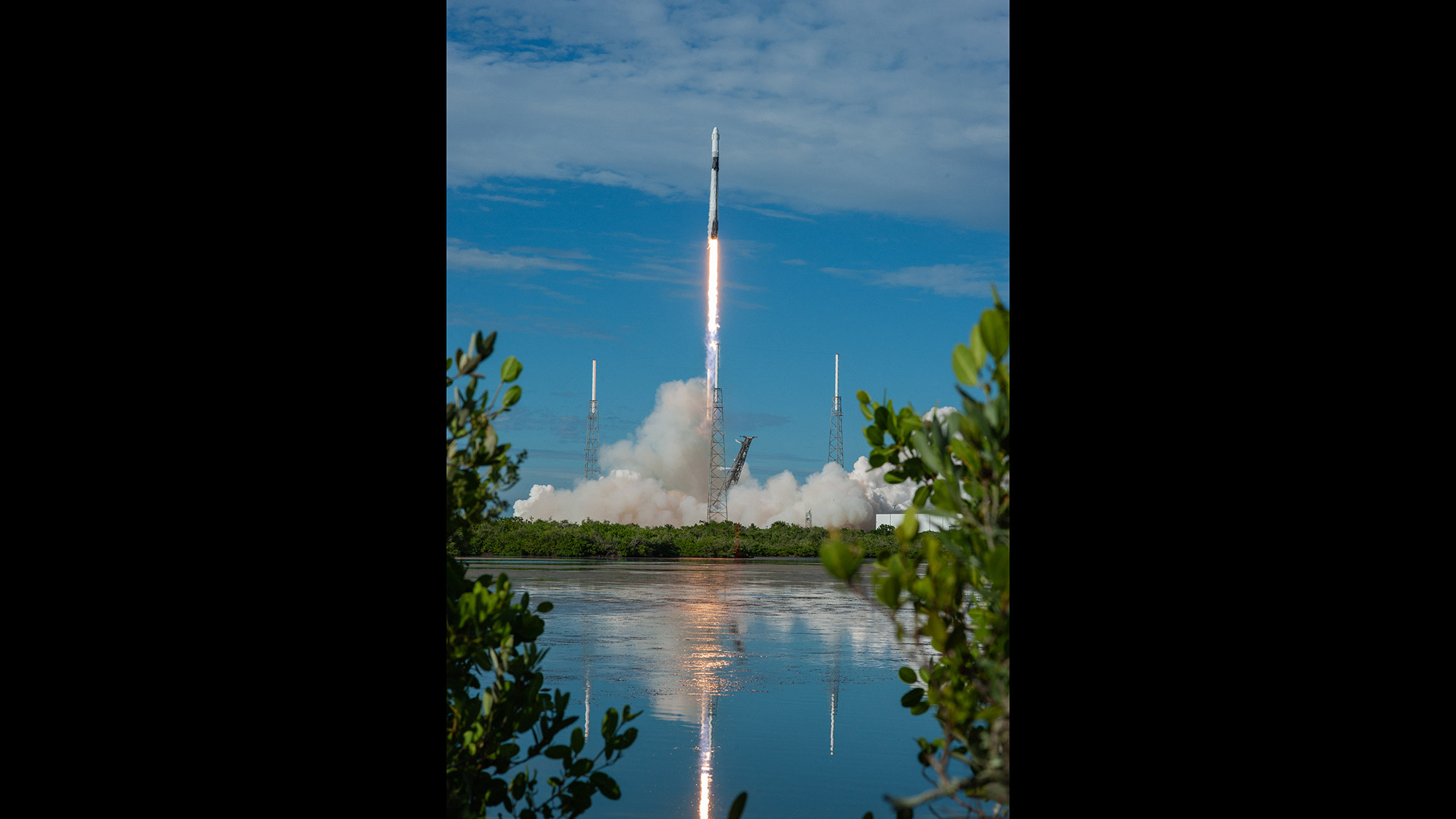
A view through foliage of SpaceX's CRS-18 Dragon departing Earth.
Dragon will stay in orbit for about four weeks before returning to Earth to deliver experiment results and other gear back to Earth.
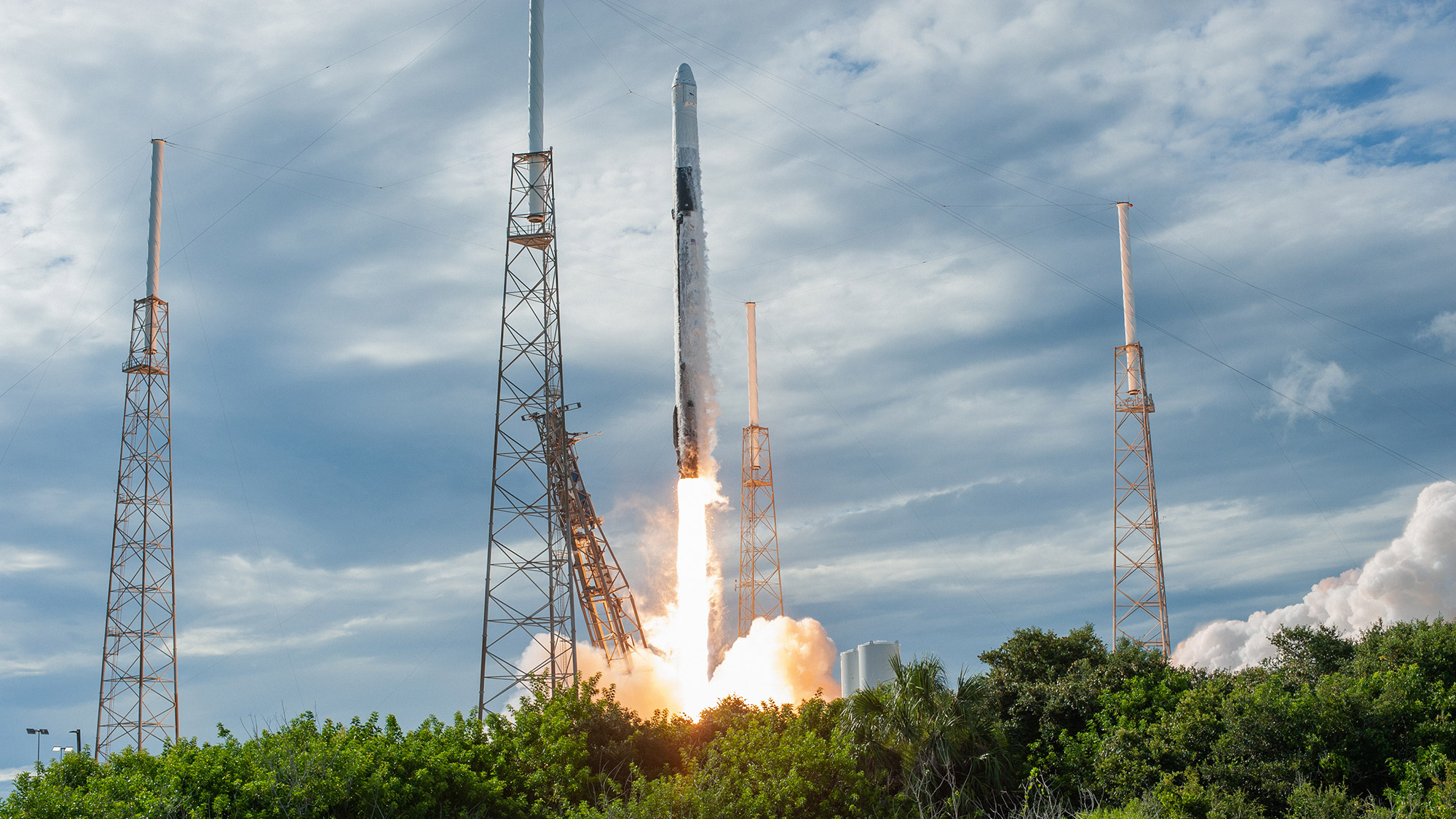
Another dazzling view of launch for SpaceX's CRS-18 Dragon resupply mission.
The four towers you see around Space Launch Complex 40 here are protective lightning towers to prevent SpaceX rockets from lightning during foul weather. The Strongback device that typically secures Falcon 9 vehicles while awaiting launch can be seen just to the left of the rocket in this view in its "release" location.
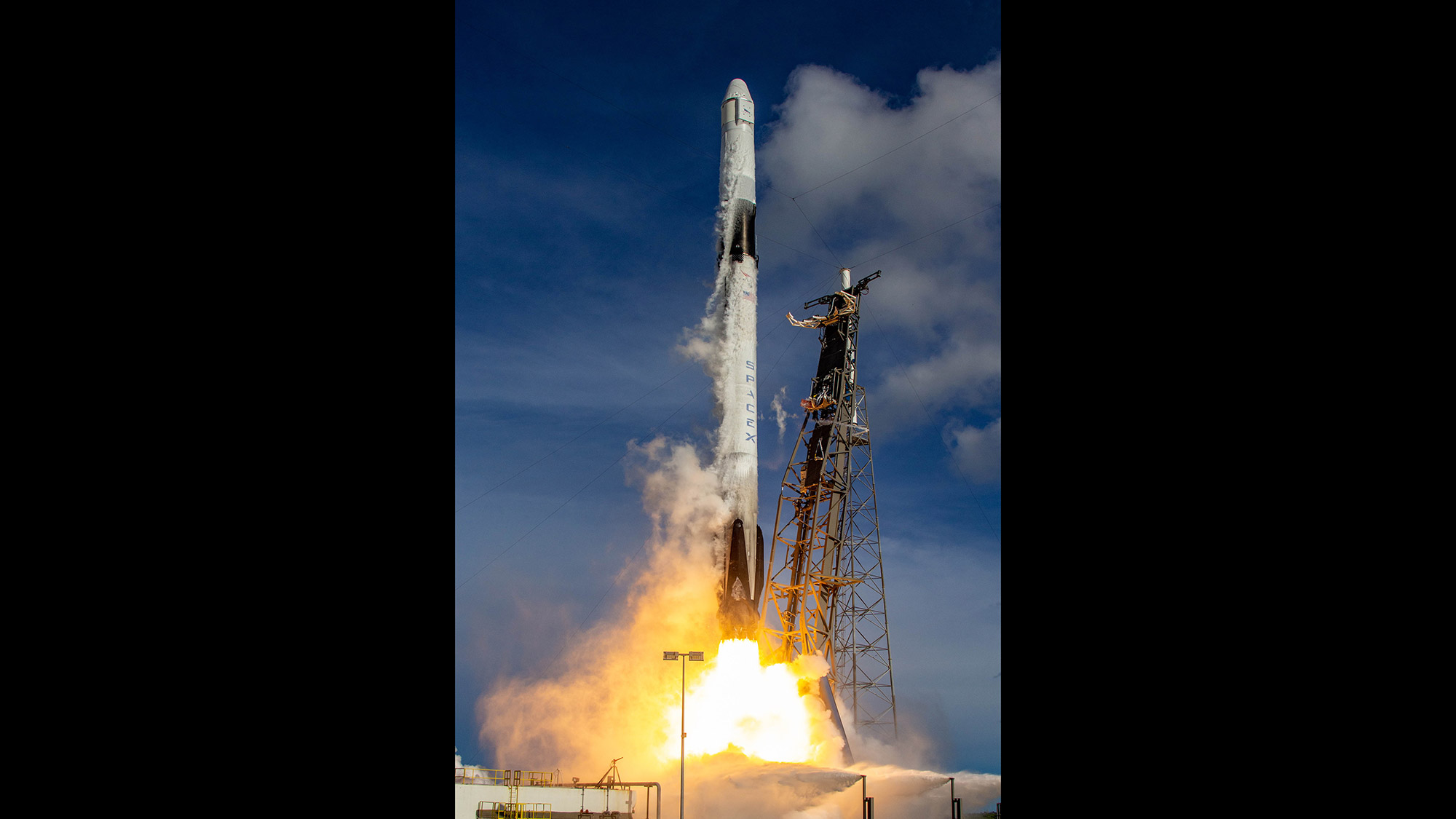
The nine Merlin engines of SpaceX's Falcon 9 rocket ignite to launch CRS-18 Dragon on its way.
SpaceX's Falcon 9 first stage fires its engines for 162 seconds, building up 1.7 million pounds of thrust at sea level, but can reach up to 1.8 million pounds of thrust in vacuum.
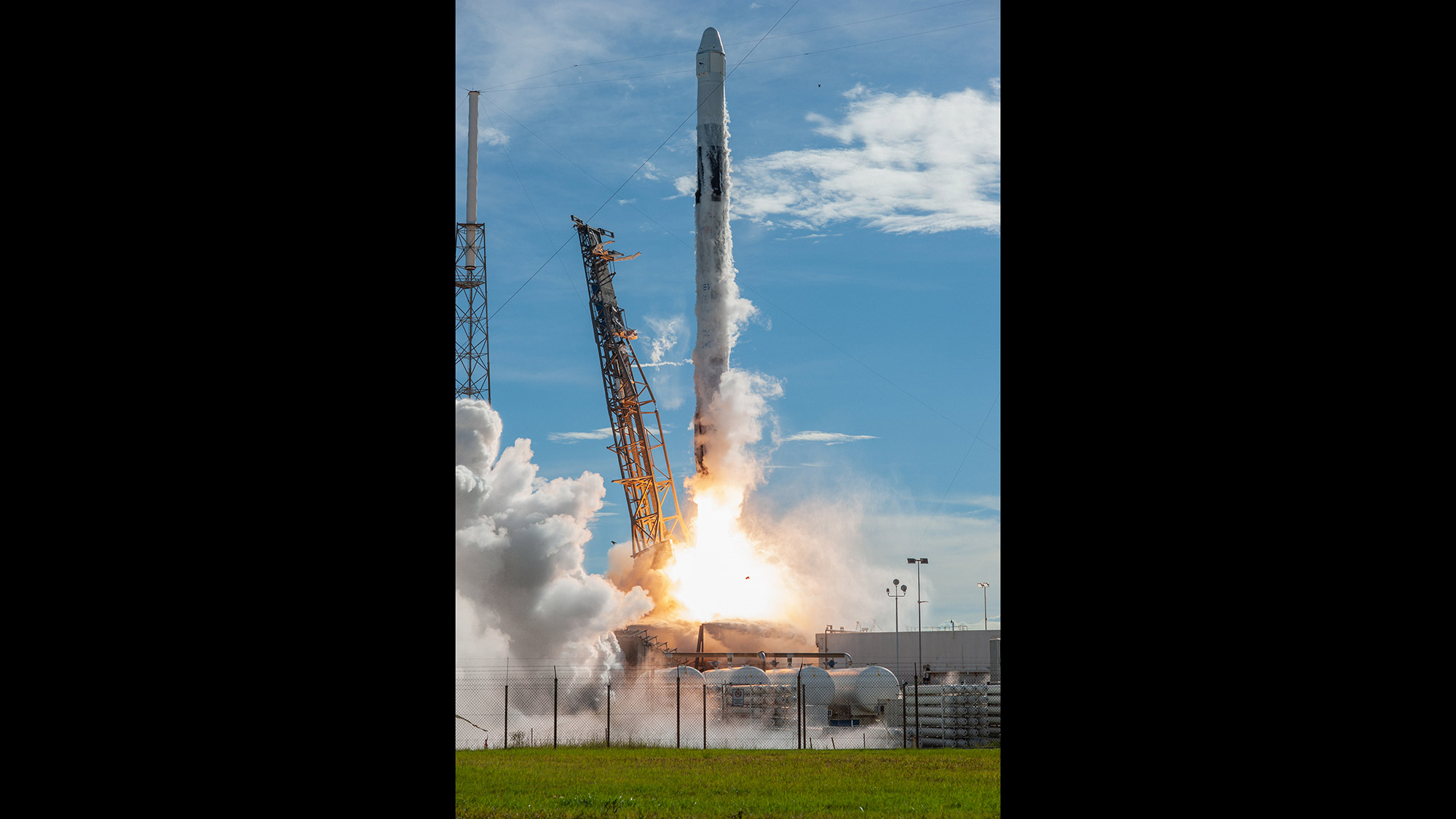
If you're wondering what 1.7 million pounds of thrust actually means, consider this.
SpaceX's Falcon 9 first stage generates more thrust at liftoff than five Boeing 747 jumbo jets at full power. SpaceX test fires a Falcon 9 first stage a few days before launch to make sure it is ready for actual spaceflight.
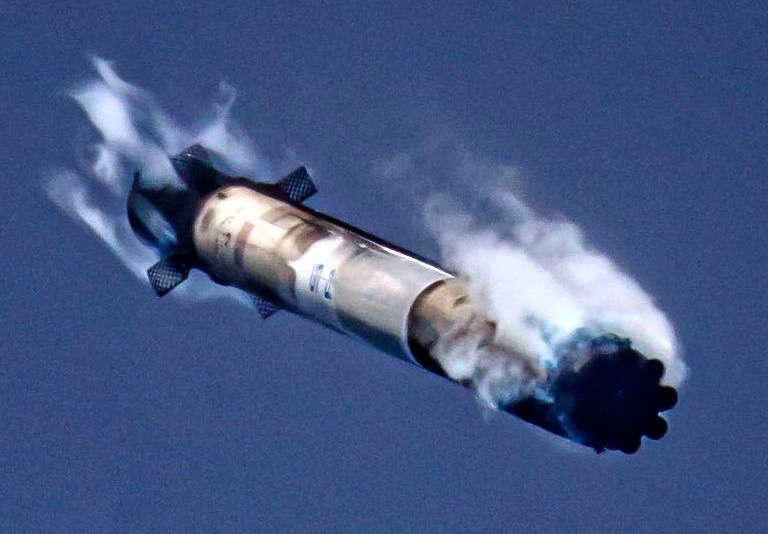
Behold, the reusable rocket returns.
This amazing view of the CRS-18 Falcon 9 rocket's first stage was captured by photographer Jim Poppino and released by SpaceX CEO Elon Musk to showcase the reusable rocket.
This particular Falcon 9 rocket first launched a Dragon cargo ship to the International Space Station in May 2018 before being refueled and readied for another flight. It generated two sonic booms as it returned to Earth.
The four grid fins at upper left were used to stabilize the booster during its descent to Earth.
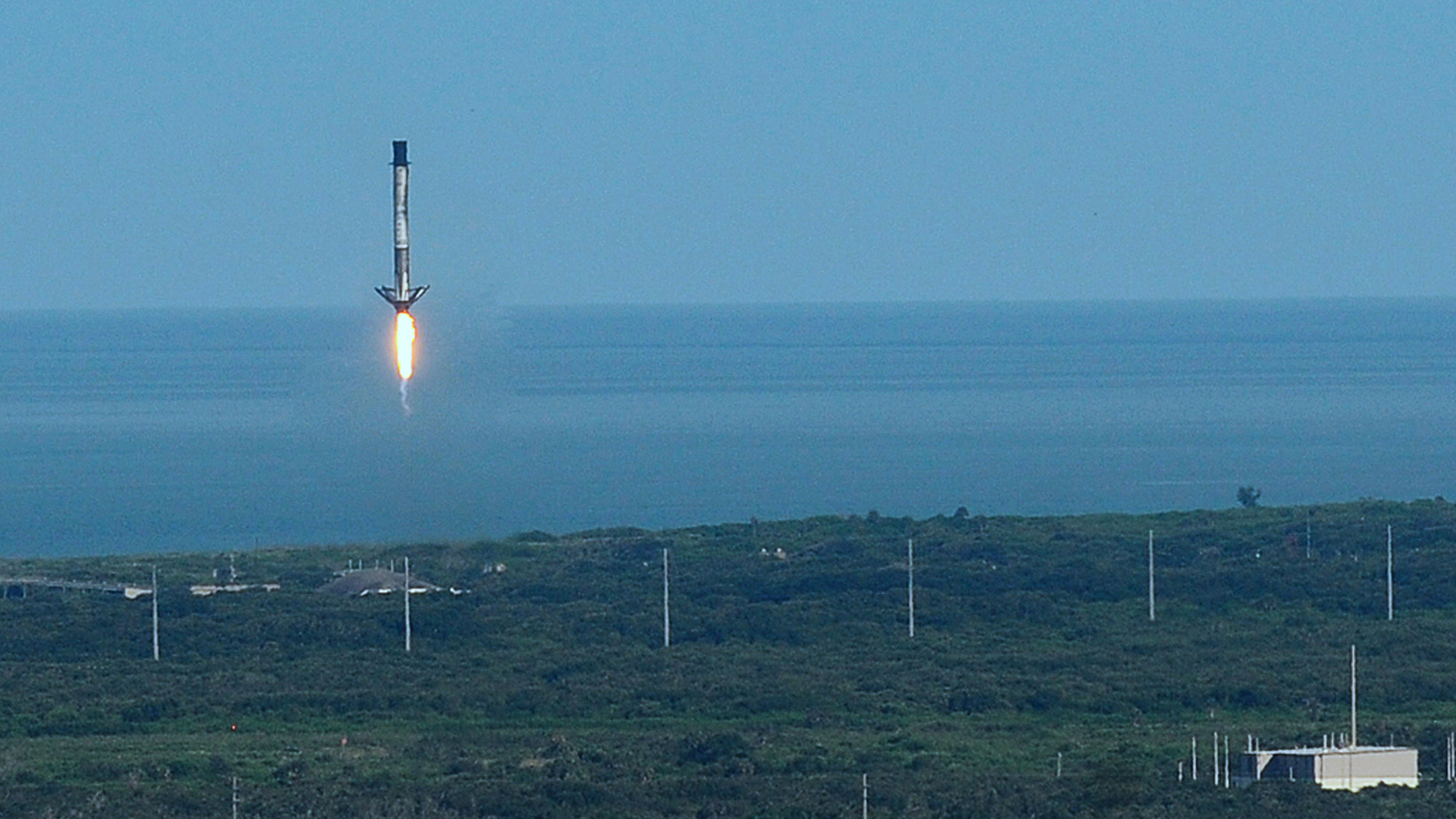
The Falcon 9 booster is caught in mid-landing gear deploy as it lowers its four legs ahead of a landing at SpaceX's Landing Zone 1 at Cape Canaveral Air Force Station in Florida. SpaceX has pulled off more than 40 rocket landings over the years.
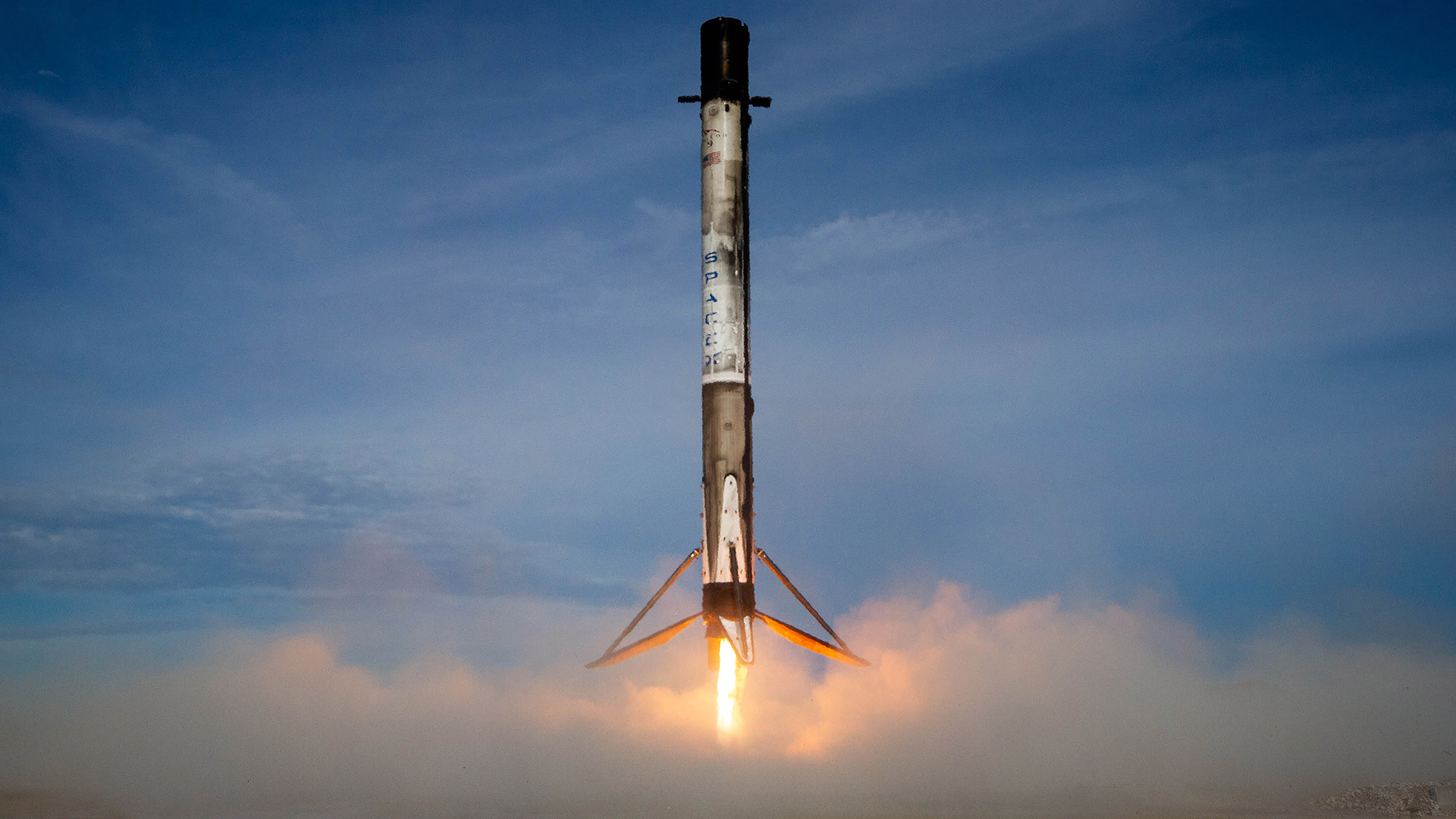
Touchdown!
An even sootier Falcon 9 nails its landing after successfully launching the CRS-18 Dragon cargo ship into orbit.
The Falcon 9 rocket landed about 8 minutes and 23 seconds after liftoff. As it landed, the rocket's upper stage was still carrying the Dragon capsule into space.
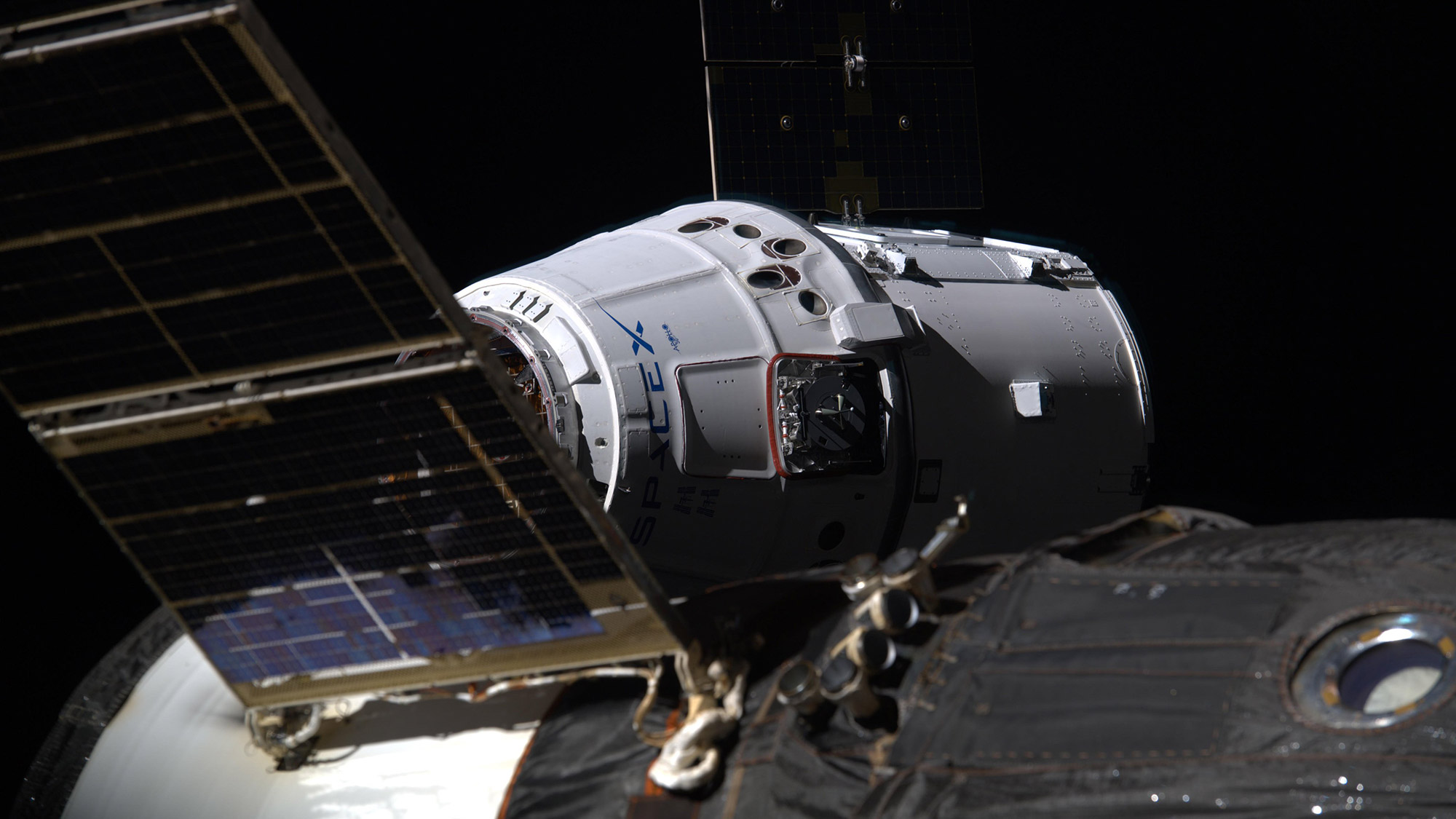
It took SpaceX's CRS-18 Dragon about two days to reach the International Space Station. It arrived on Saturday, July 27, 2019.
Here, European Space Agency astronaut Luca Parmitano snaps a photo of Dragon as it nears the space station during rendezvous operations.
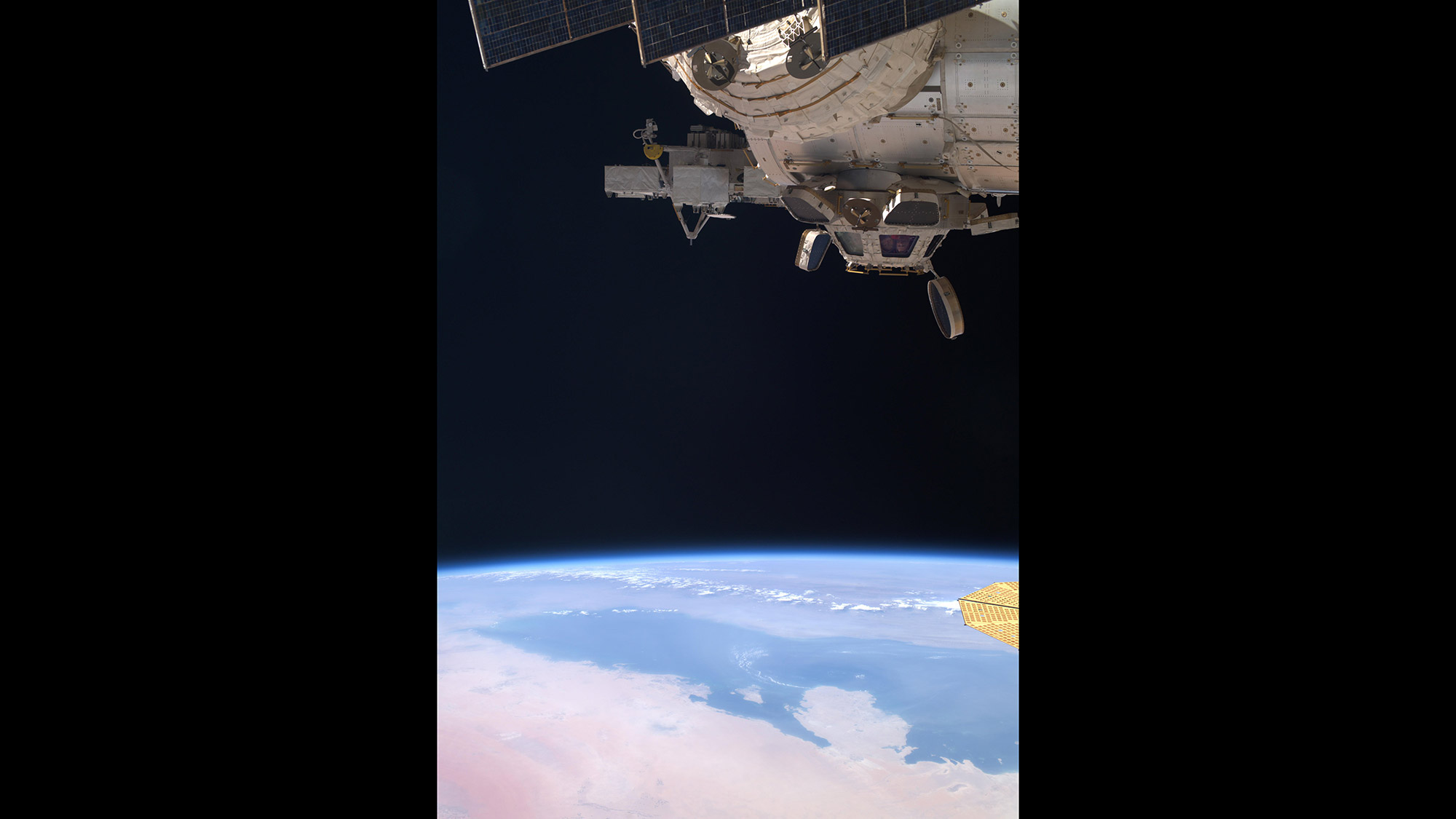
Look closely at this image and you'll see three NASA astronauts inside the Cupola, a seven-windowed observation area of the International Space Station, looking down as they await Dragon's CRS-18 cargo arrival. They're not just having fun, space station crews must monitor Dragon's approach in order to capture the spacecraft.
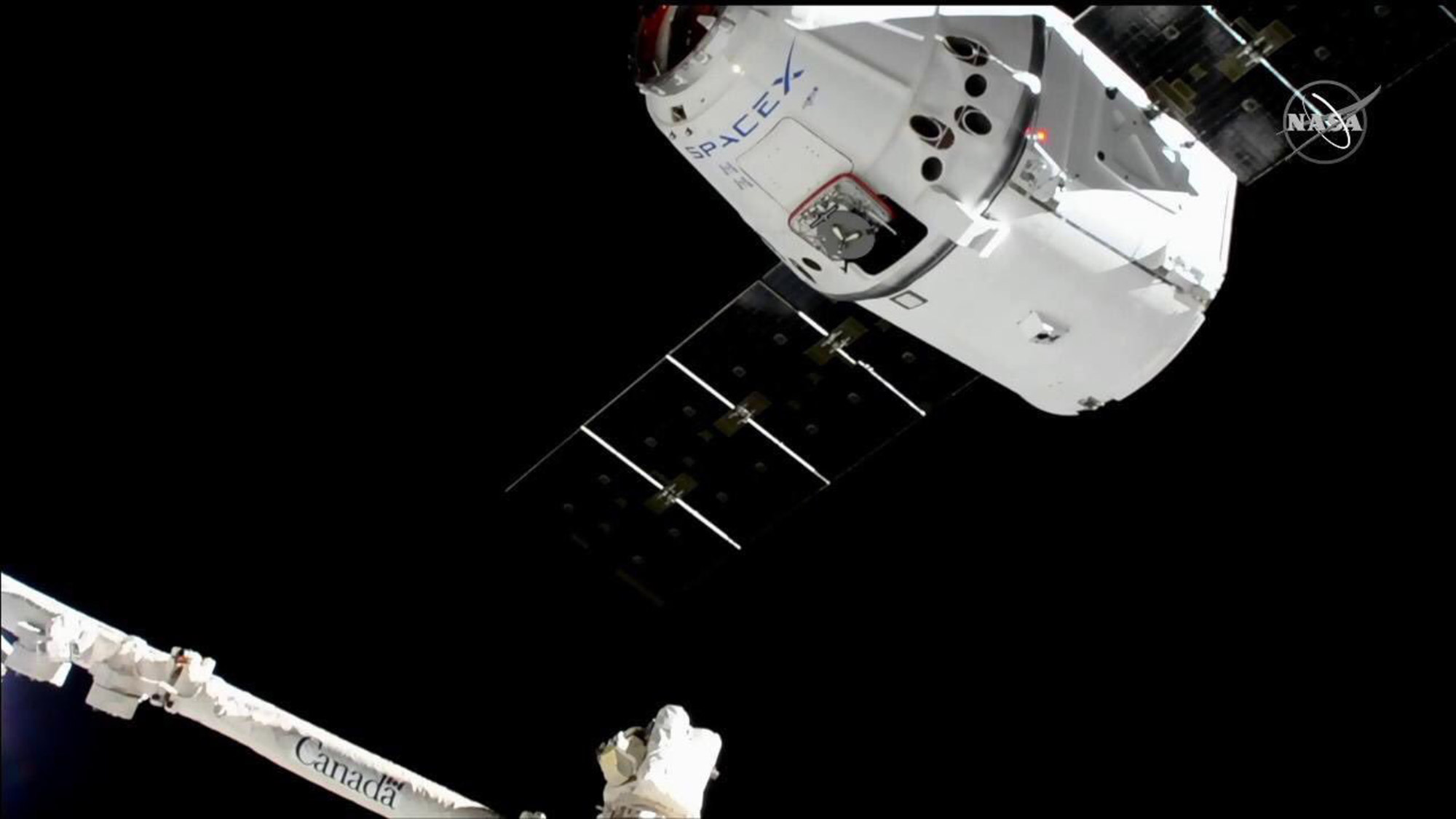
Dragon hovers near the International Space Station in this view taken by astronauts aboard the orbiting lab on July 29, 2019.
At bottom is the Canadarm2, the robotic arm of the International Space Station, which NASA astronauts used to latch on to a connector on Dragon (the small, gray pointy bit just under the SpaceX logo.
SpaceX's Dragon cargo ships cannot dock themselves to the space station. Instead, they are captured by robotic arm and attached to an open berthing port.
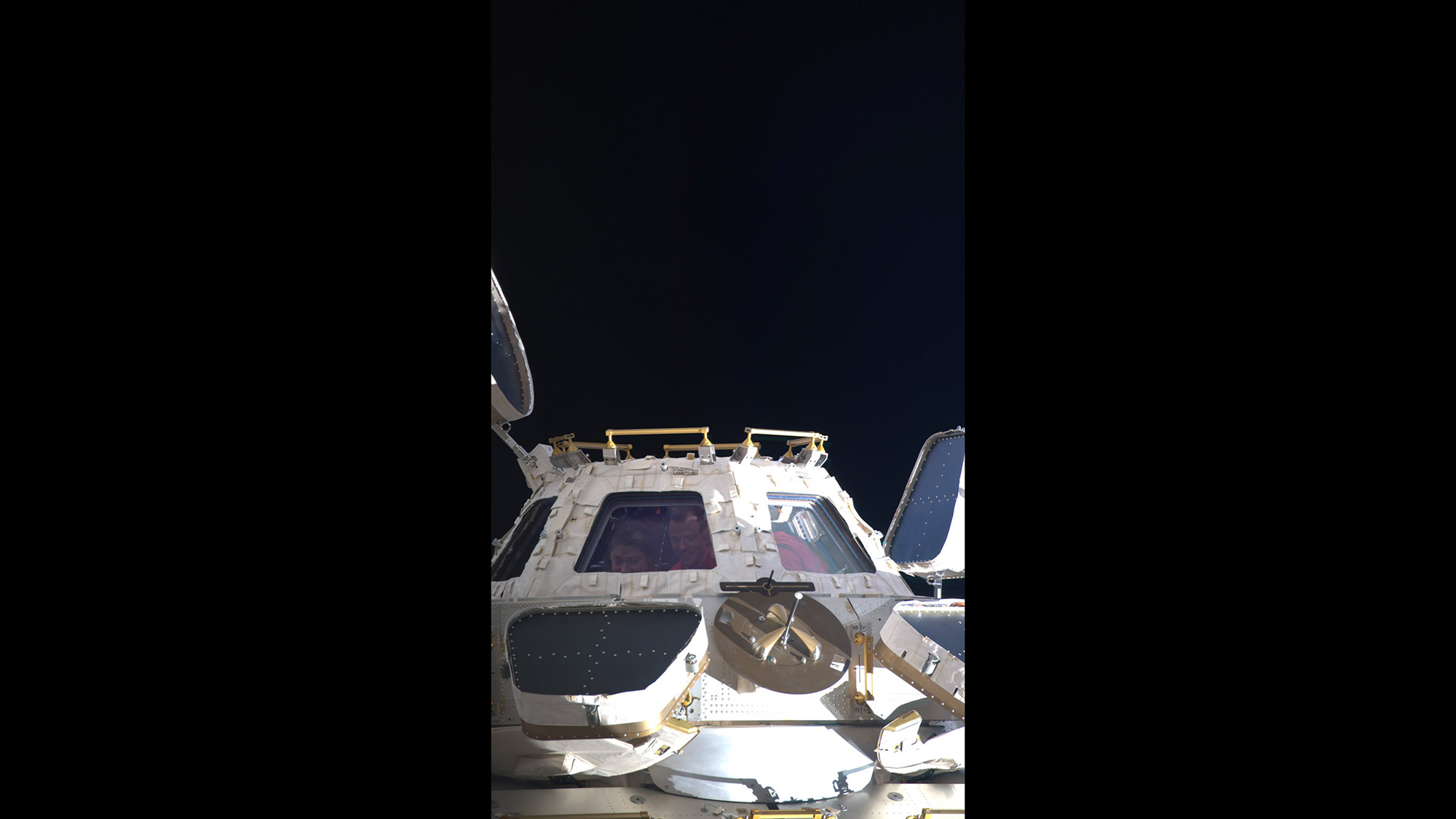
During rendezvous operations, NASA astronauts Nick Hague, Christina Koch and Andrew Morgan kept close watch on the approaching Dragon spacecraft.
This photo was taken by European Space Agency astronaut Luca Parmitano, who watched Dragon's arrival from a different vantage point aboard the space station.
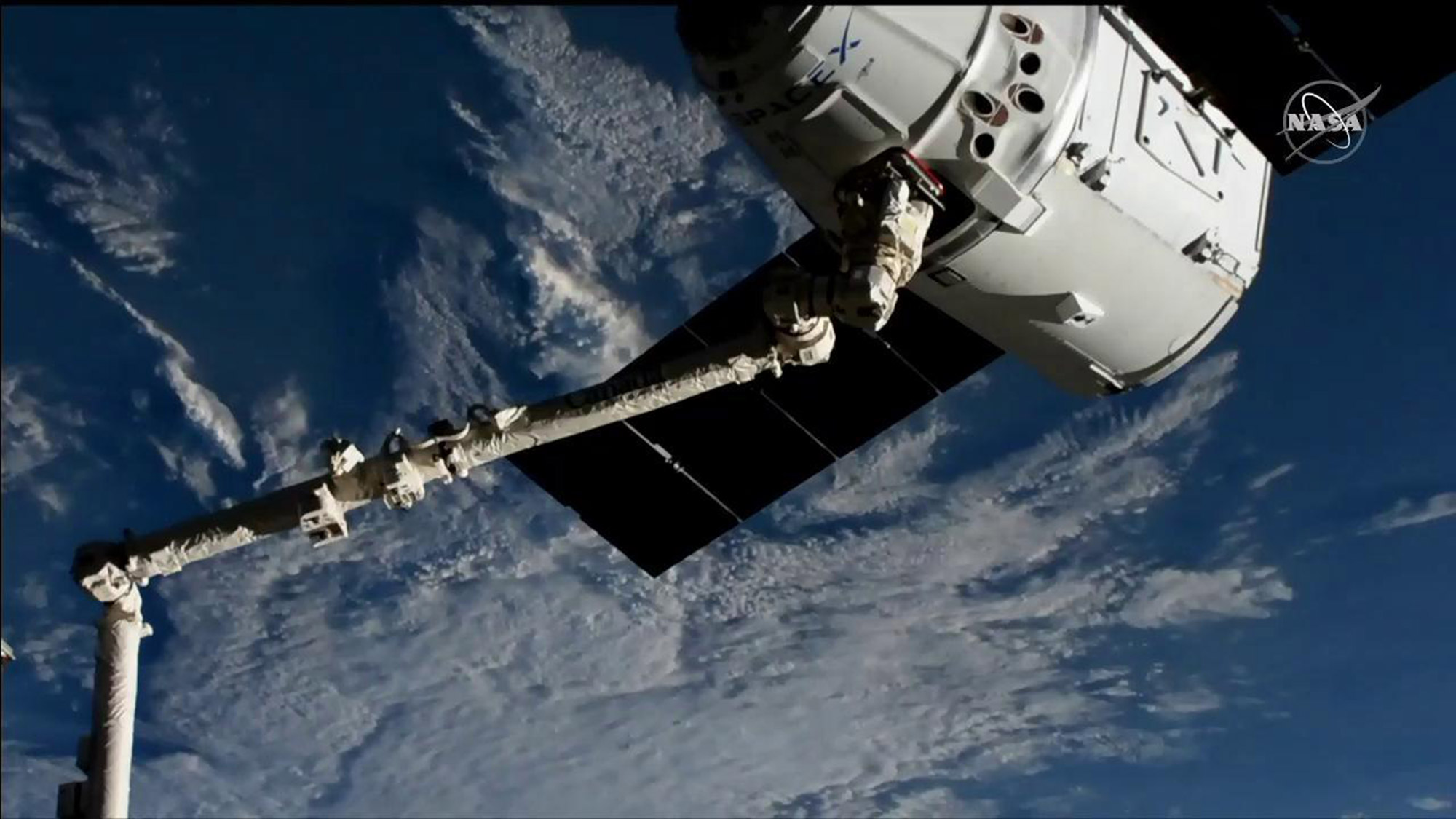
CAPTURE!
The International Space Station crew captured Dragon with the Canadarm2 robotic arm at 9:11 a.m. EDT (1311 GMT) on Saturday, July 27, 2019.
At the time of capture, Dragon and the space station were flying 267 miles (430 kilometers) above the coast of southern Chile in South America.
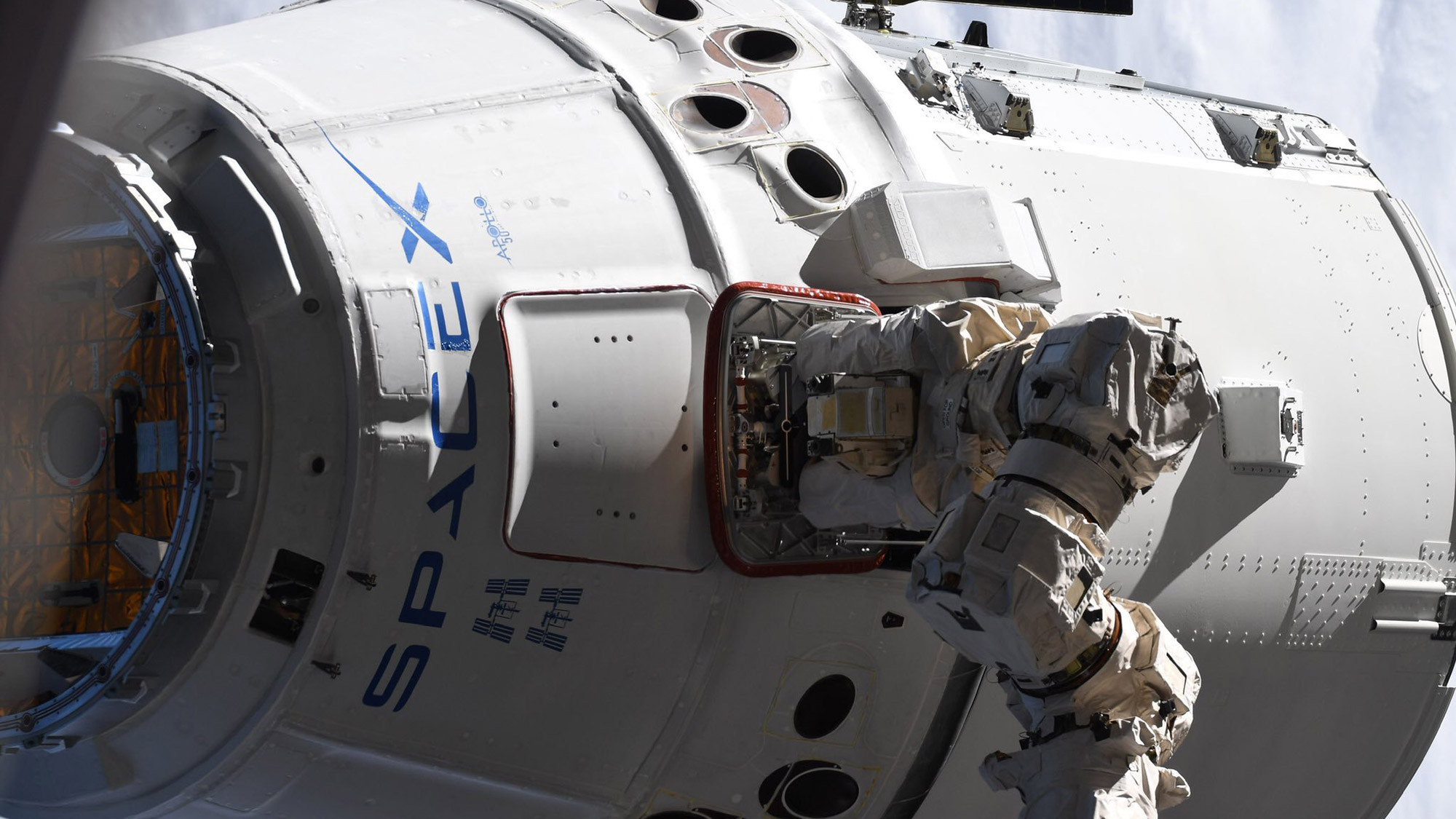
An astronaut's secret weapon for catching a SpaceX Dragon is the Canadarm2, a 57-foot (17 meters) robotic arm tipped with an "end effector" that can latch onto a connecting device on Dragon's hull.
Astronauts use the arm to capture Dragon after the SpaceX capsule has reached a holding point near the space station. Once captured, astronauts turn control of the robotic arm over to flight controllers in Mission Control at NASA's Johnson Space Center in Houston. Those flight controllers remotely operate the arm to attach the Dragon to an open berthing point.
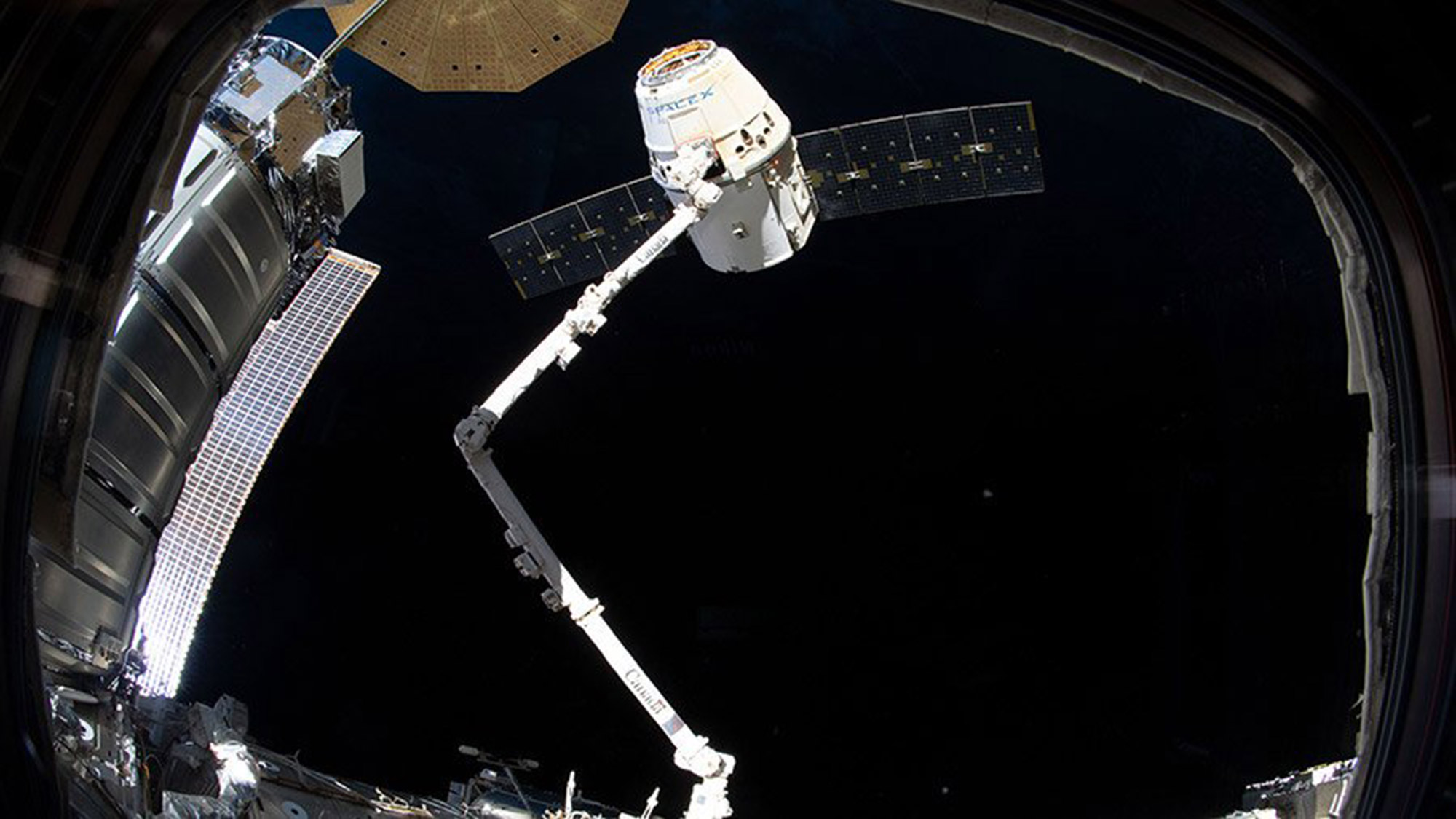
SpaceX is not the only private company to deliver NASA cargo to the International Space Station.
This view through a Cupola window show Dragon at the end of the station's Canadarm2. At far left is a cylindrical Cygnus cargo ship (the round gold structure is a solar array).
Cygnus vehicles are built by Northrop Grumman Innovation Systems and launch to the space station on Northrop Grumman's Antares rocket. Like the Dragon cargo ship, Cygnus vehicles do not carry astronauts.
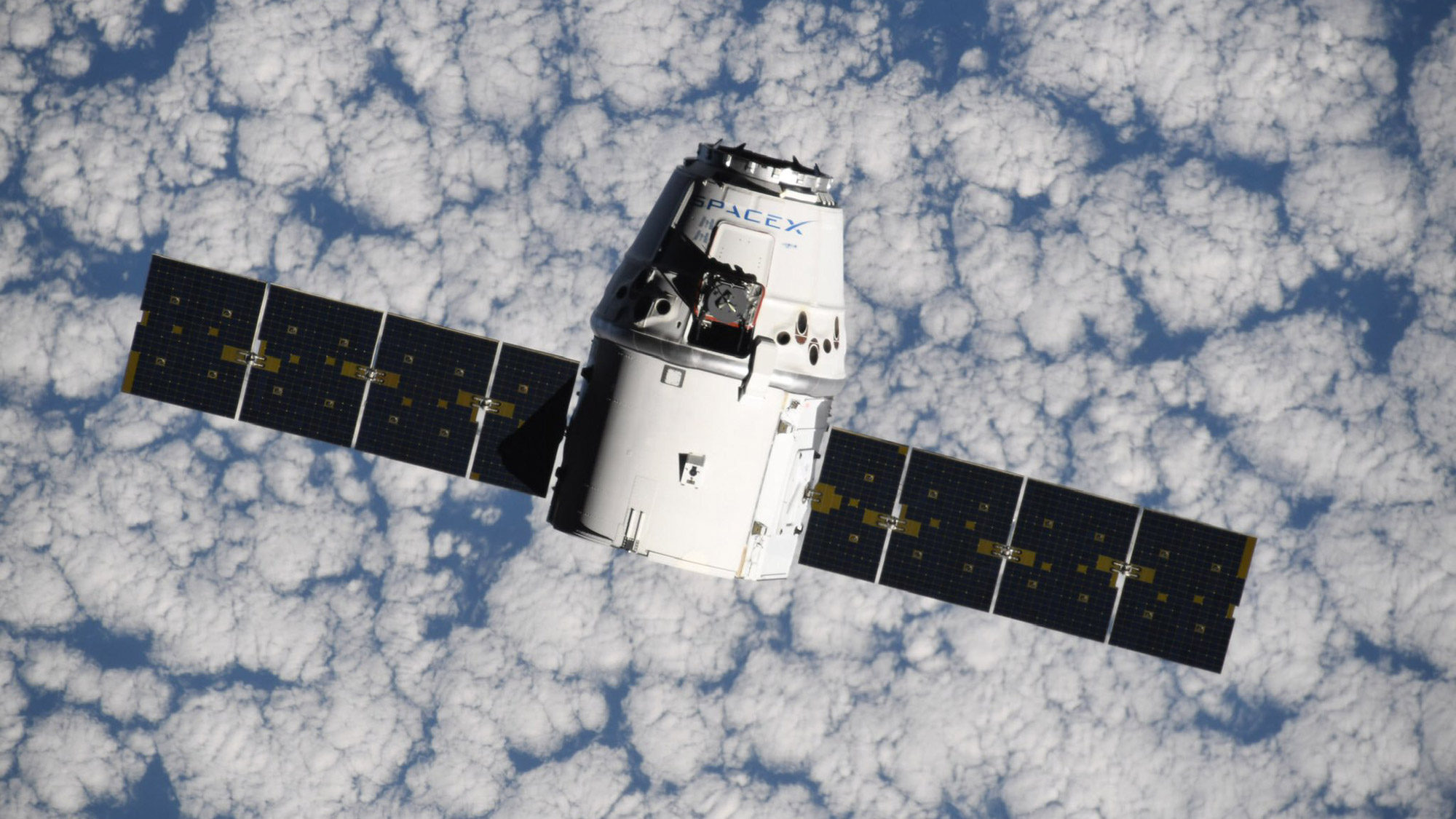
A view of SpaceX's CRS-18 Dragon as it approached the International Space Station.
Dragon vehicles are solar-powered (the panels can be seen reaching out from its main service module). The actual Dragon capsule is the gumdrop-shaped module at the top in this view. They cylindrical "trunk" at bottom houses the solar arrays, storage for unpressurized cargo and other gear needed while Dragon is in orbit.
During reentry, Dragon will jettison the trunk so that only the conical capsule returns to Earth.

This closer look shows the entry hatch (in gold) that astronauts will use to enter Dragon once it was attached to the International Space Station.
Dragon vehicles are designed to attach to so-called Common Berthing Mechanisms on different modules of the space station. Once attached, astronauts conduct leak checks to ensure a tight seal, then open hatches between the two spacecraft to access the pressurized cargo inside.
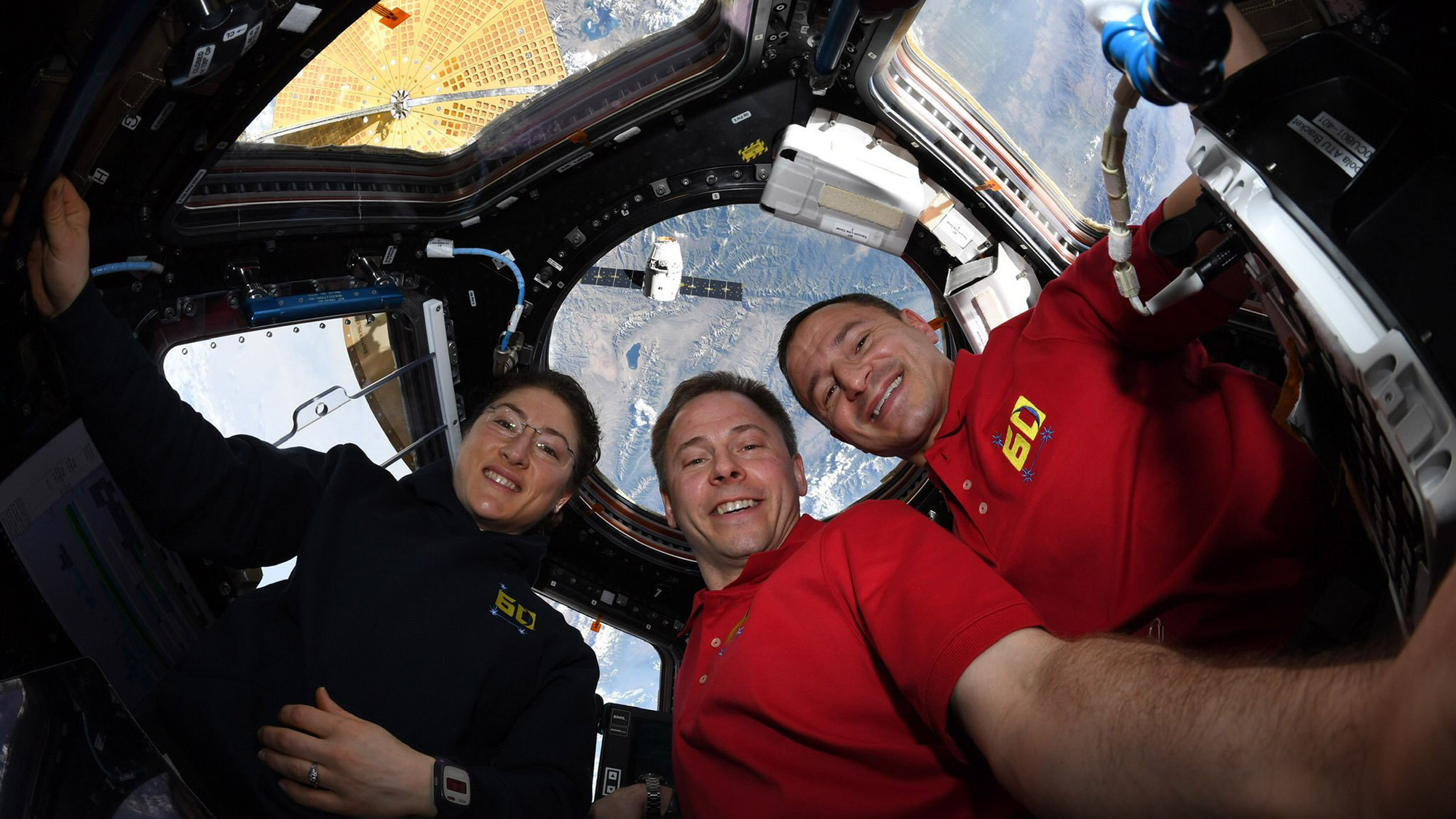
NASA astronauts Christina Koch (left), Nick Hague (center) and Drew Morgan smile as they prepare to welcome SpaceX's Dragon cargo ship to the International Space Station on July 27, 2019.
Dragon is visible in the central window of the station's Cupola observation deck in this view.
The spacecraft will remain attached to the space station for four weeks, after which time it will be filled with experiment results and other gear headed back to Earth and will return to the planet below.

Tariq is the award-winning Editor-in-Chief of Space.com and joined the team in 2001. He covers human spaceflight, as well as skywatching and entertainment. He became Space.com's Editor-in-Chief in 2019. Before joining Space.com, Tariq was a staff reporter for The Los Angeles Times covering education and city beats in La Habra, Fullerton and Huntington Beach. He's a recipient of the 2022 Harry Kolcum Award for excellence in space reporting and the 2025 Space Pioneer Award from the National Space Society. He is an Eagle Scout and Space Camp alum with journalism degrees from the USC and NYU. You can find Tariq at Space.com and as the co-host to the This Week In Space podcast on the TWiT network. To see his latest project, you can follow Tariq on Twitter @tariqjmalik.
